Leadership and Effecting Change in Public Health: A Scenario Analysis
VerifiedAdded on 2023/01/18
|10
|2692
|67
Report
AI Summary
This report analyzes a scenario involving Helen, a general practitioner transitioning into a public health leadership role in Warnambool, Victoria. The analysis explores her challenges in engaging a close-knit community, advocating for equitable access to services, and addressing the lack of specialist care in the remote area. The report examines key leadership aspects, including achieving outcomes, leading self, engaging others, driving innovation, and shaping systems. It also includes a self-assessment of leadership skills, reflecting on strengths such as experience and trustworthiness and areas for development. The report concludes with recommendations for Helen to effectively manage her new role, foster a collaborative environment, and promote positive change within the community.
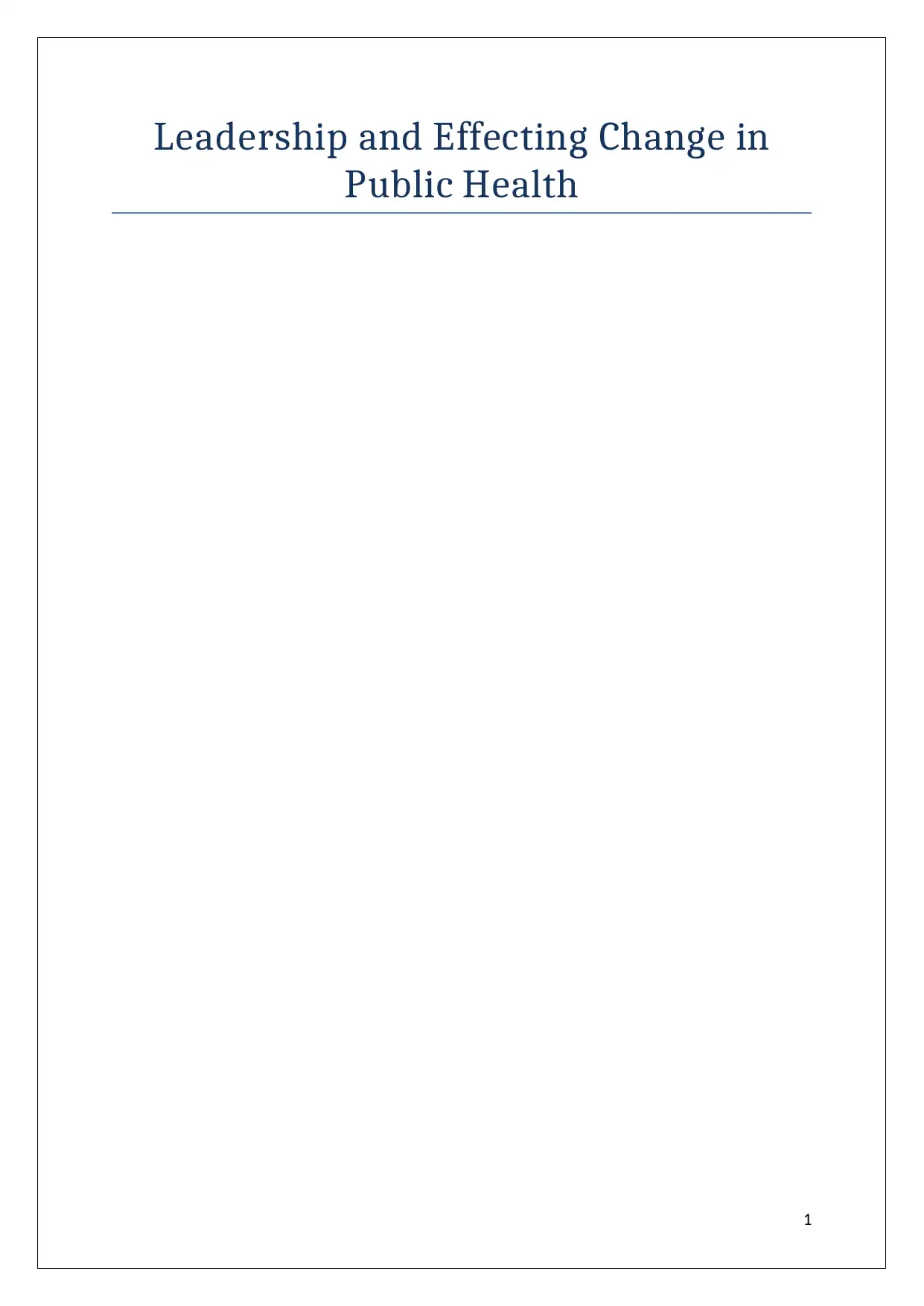
Leadership and Effecting Change in
Public Health
1
Public Health
1
Paraphrase This Document
Need a fresh take? Get an instant paraphrase of this document with our AI Paraphraser
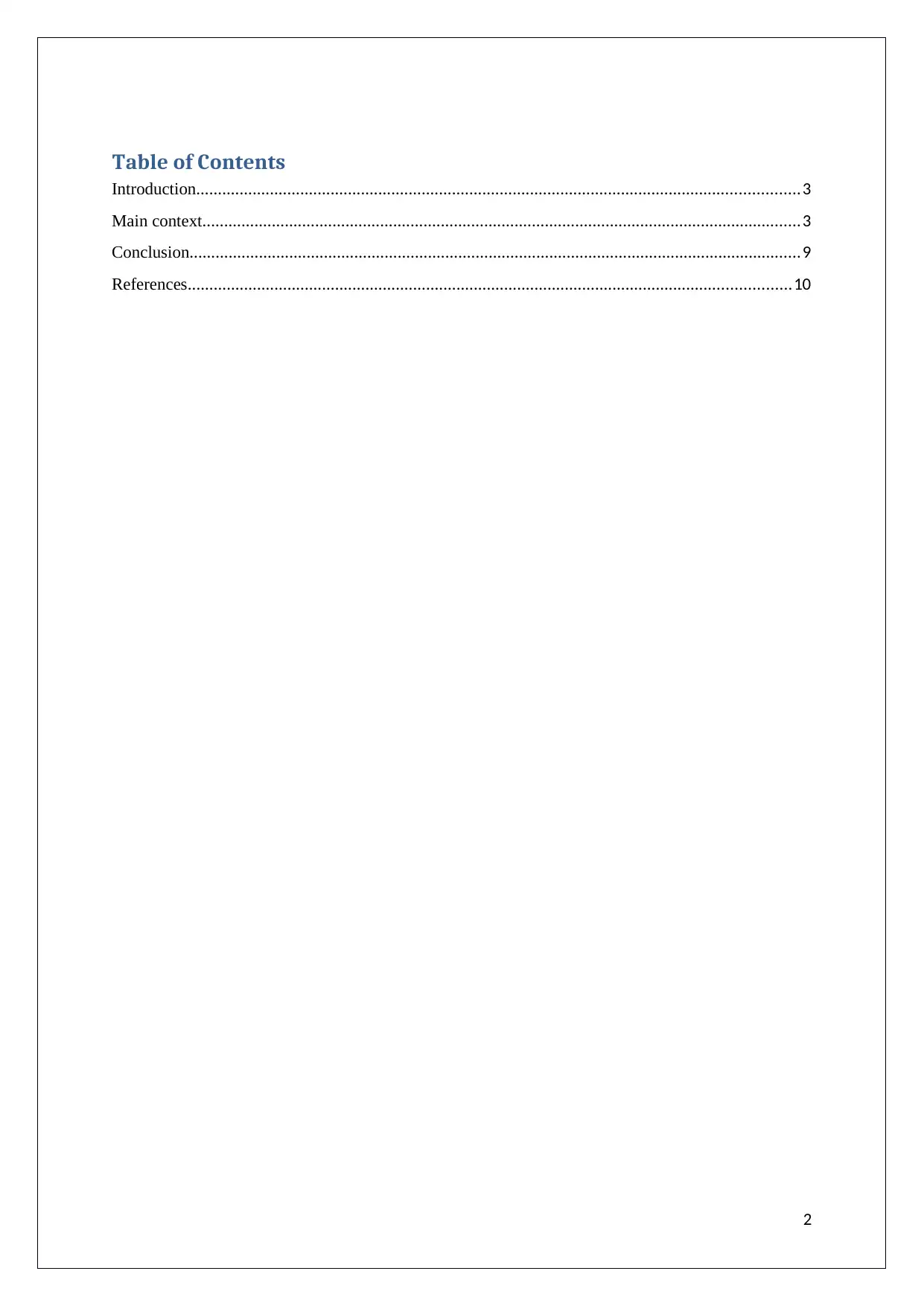
Table of Contents
Introduction...........................................................................................................................................3
Main context..........................................................................................................................................3
Conclusion.............................................................................................................................................9
References...........................................................................................................................................10
2
Introduction...........................................................................................................................................3
Main context..........................................................................................................................................3
Conclusion.............................................................................................................................................9
References...........................................................................................................................................10
2
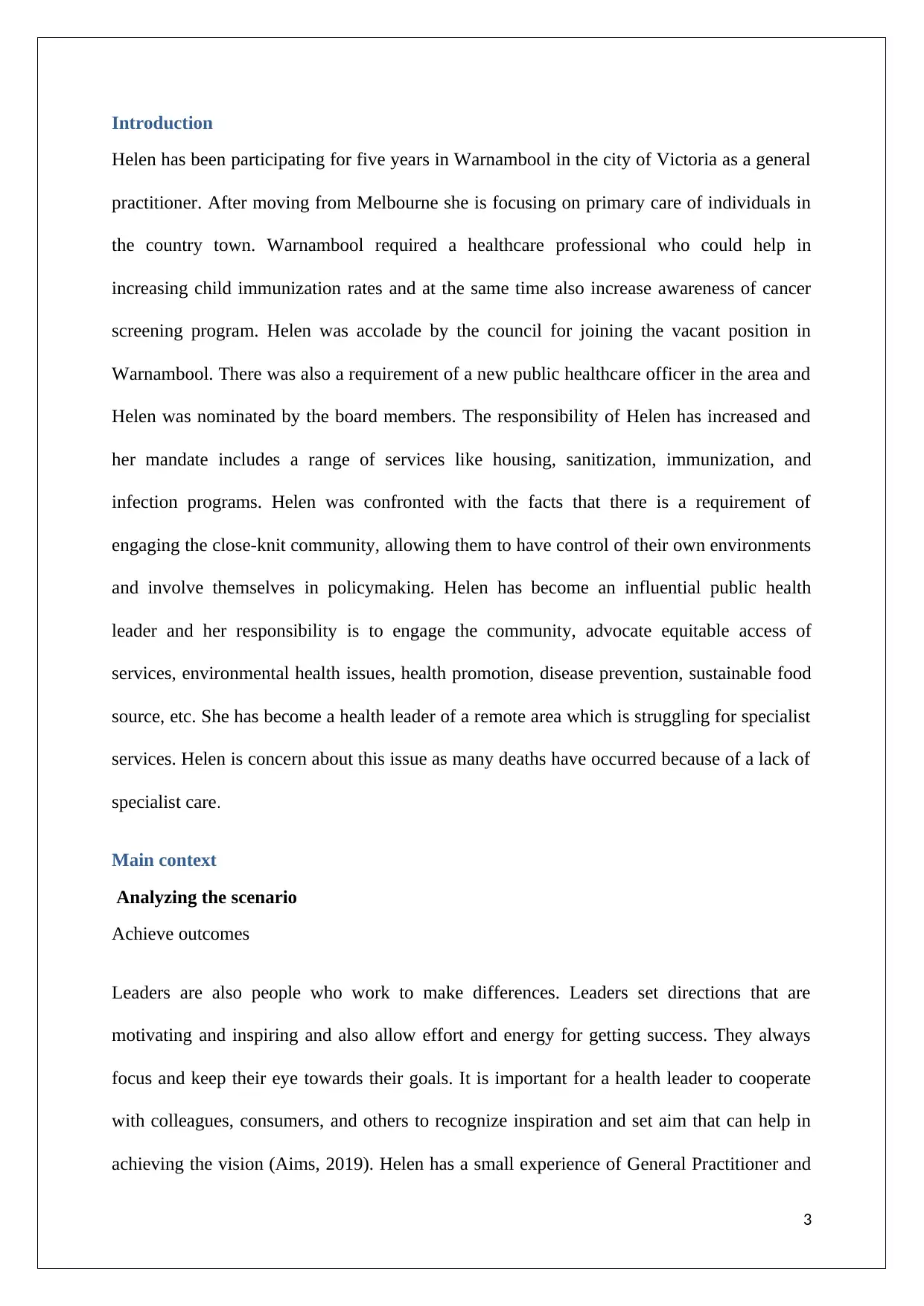
Introduction
Helen has been participating for five years in Warnambool in the city of Victoria as a general
practitioner. After moving from Melbourne she is focusing on primary care of individuals in
the country town. Warnambool required a healthcare professional who could help in
increasing child immunization rates and at the same time also increase awareness of cancer
screening program. Helen was accolade by the council for joining the vacant position in
Warnambool. There was also a requirement of a new public healthcare officer in the area and
Helen was nominated by the board members. The responsibility of Helen has increased and
her mandate includes a range of services like housing, sanitization, immunization, and
infection programs. Helen was confronted with the facts that there is a requirement of
engaging the close-knit community, allowing them to have control of their own environments
and involve themselves in policymaking. Helen has become an influential public health
leader and her responsibility is to engage the community, advocate equitable access of
services, environmental health issues, health promotion, disease prevention, sustainable food
source, etc. She has become a health leader of a remote area which is struggling for specialist
services. Helen is concern about this issue as many deaths have occurred because of a lack of
specialist care.
Main context
Analyzing the scenario
Achieve outcomes
Leaders are also people who work to make differences. Leaders set directions that are
motivating and inspiring and also allow effort and energy for getting success. They always
focus and keep their eye towards their goals. It is important for a health leader to cooperate
with colleagues, consumers, and others to recognize inspiration and set aim that can help in
achieving the vision (Aims, 2019). Helen has a small experience of General Practitioner and
3
Helen has been participating for five years in Warnambool in the city of Victoria as a general
practitioner. After moving from Melbourne she is focusing on primary care of individuals in
the country town. Warnambool required a healthcare professional who could help in
increasing child immunization rates and at the same time also increase awareness of cancer
screening program. Helen was accolade by the council for joining the vacant position in
Warnambool. There was also a requirement of a new public healthcare officer in the area and
Helen was nominated by the board members. The responsibility of Helen has increased and
her mandate includes a range of services like housing, sanitization, immunization, and
infection programs. Helen was confronted with the facts that there is a requirement of
engaging the close-knit community, allowing them to have control of their own environments
and involve themselves in policymaking. Helen has become an influential public health
leader and her responsibility is to engage the community, advocate equitable access of
services, environmental health issues, health promotion, disease prevention, sustainable food
source, etc. She has become a health leader of a remote area which is struggling for specialist
services. Helen is concern about this issue as many deaths have occurred because of a lack of
specialist care.
Main context
Analyzing the scenario
Achieve outcomes
Leaders are also people who work to make differences. Leaders set directions that are
motivating and inspiring and also allow effort and energy for getting success. They always
focus and keep their eye towards their goals. It is important for a health leader to cooperate
with colleagues, consumers, and others to recognize inspiration and set aim that can help in
achieving the vision (Aims, 2019). Helen has a small experience of General Practitioner and
3
⊘ This is a preview!⊘
Do you want full access?
Subscribe today to unlock all pages.

Trusted by 1+ million students worldwide
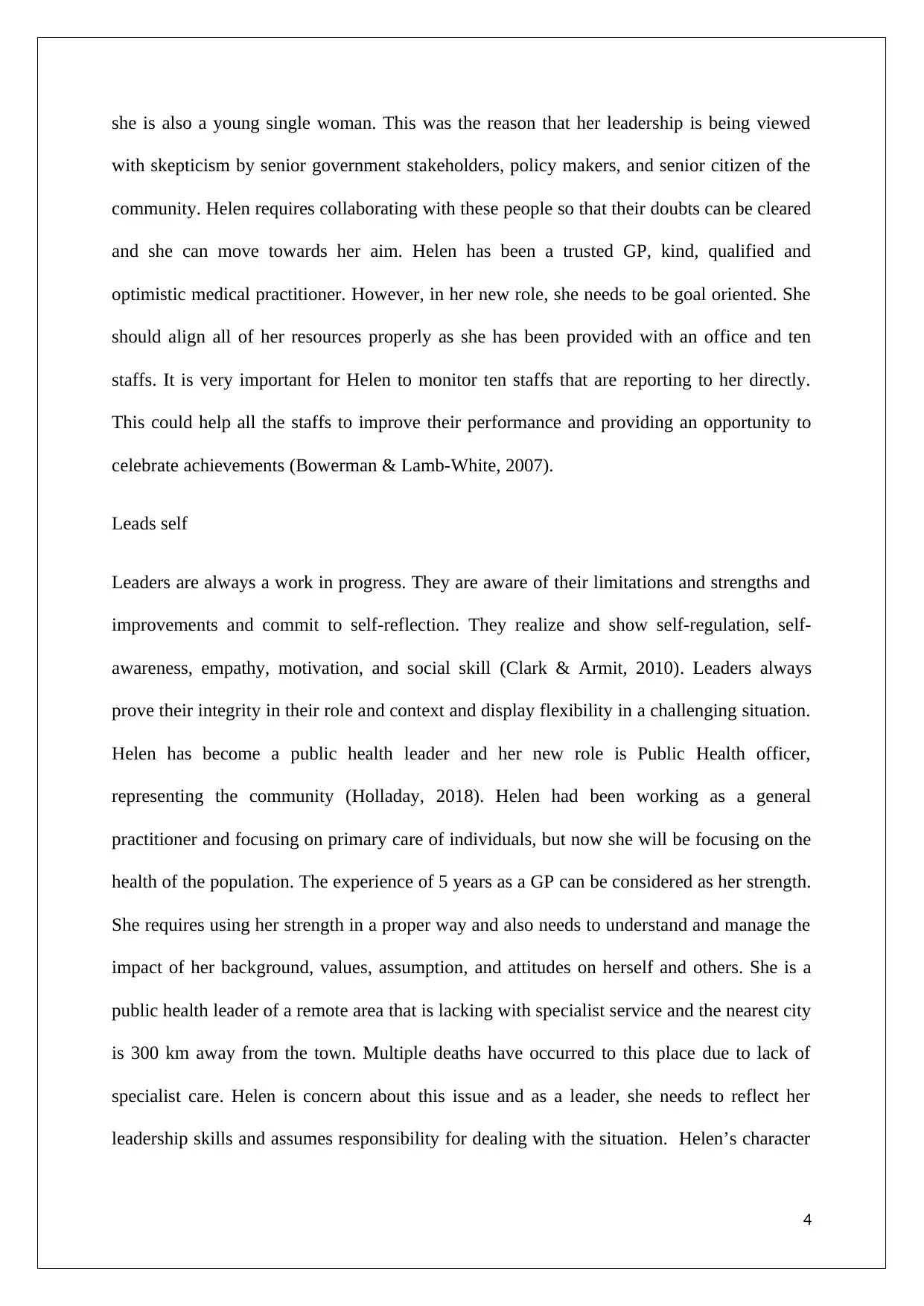
she is also a young single woman. This was the reason that her leadership is being viewed
with skepticism by senior government stakeholders, policy makers, and senior citizen of the
community. Helen requires collaborating with these people so that their doubts can be cleared
and she can move towards her aim. Helen has been a trusted GP, kind, qualified and
optimistic medical practitioner. However, in her new role, she needs to be goal oriented. She
should align all of her resources properly as she has been provided with an office and ten
staffs. It is very important for Helen to monitor ten staffs that are reporting to her directly.
This could help all the staffs to improve their performance and providing an opportunity to
celebrate achievements (Bowerman & Lamb-White, 2007).
Leads self
Leaders are always a work in progress. They are aware of their limitations and strengths and
improvements and commit to self-reflection. They realize and show self-regulation, self-
awareness, empathy, motivation, and social skill (Clark & Armit, 2010). Leaders always
prove their integrity in their role and context and display flexibility in a challenging situation.
Helen has become a public health leader and her new role is Public Health officer,
representing the community (Holladay, 2018). Helen had been working as a general
practitioner and focusing on primary care of individuals, but now she will be focusing on the
health of the population. The experience of 5 years as a GP can be considered as her strength.
She requires using her strength in a proper way and also needs to understand and manage the
impact of her background, values, assumption, and attitudes on herself and others. She is a
public health leader of a remote area that is lacking with specialist service and the nearest city
is 300 km away from the town. Multiple deaths have occurred to this place due to lack of
specialist care. Helen is concern about this issue and as a leader, she needs to reflect her
leadership skills and assumes responsibility for dealing with the situation. Helen’s character
4
with skepticism by senior government stakeholders, policy makers, and senior citizen of the
community. Helen requires collaborating with these people so that their doubts can be cleared
and she can move towards her aim. Helen has been a trusted GP, kind, qualified and
optimistic medical practitioner. However, in her new role, she needs to be goal oriented. She
should align all of her resources properly as she has been provided with an office and ten
staffs. It is very important for Helen to monitor ten staffs that are reporting to her directly.
This could help all the staffs to improve their performance and providing an opportunity to
celebrate achievements (Bowerman & Lamb-White, 2007).
Leads self
Leaders are always a work in progress. They are aware of their limitations and strengths and
improvements and commit to self-reflection. They realize and show self-regulation, self-
awareness, empathy, motivation, and social skill (Clark & Armit, 2010). Leaders always
prove their integrity in their role and context and display flexibility in a challenging situation.
Helen has become a public health leader and her new role is Public Health officer,
representing the community (Holladay, 2018). Helen had been working as a general
practitioner and focusing on primary care of individuals, but now she will be focusing on the
health of the population. The experience of 5 years as a GP can be considered as her strength.
She requires using her strength in a proper way and also needs to understand and manage the
impact of her background, values, assumption, and attitudes on herself and others. She is a
public health leader of a remote area that is lacking with specialist service and the nearest city
is 300 km away from the town. Multiple deaths have occurred to this place due to lack of
specialist care. Helen is concern about this issue and as a leader, she needs to reflect her
leadership skills and assumes responsibility for dealing with the situation. Helen’s character
4
Paraphrase This Document
Need a fresh take? Get an instant paraphrase of this document with our AI Paraphraser
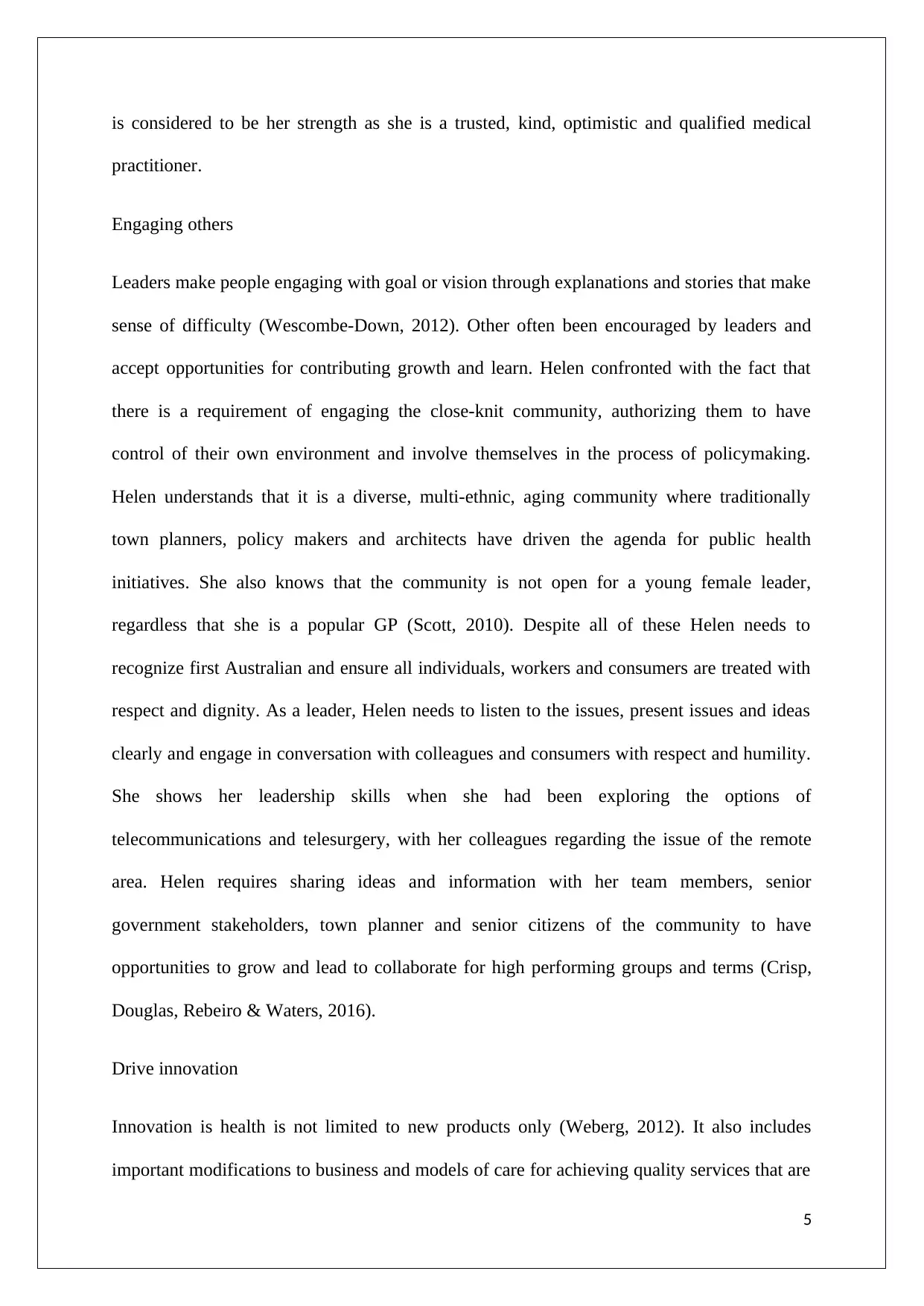
is considered to be her strength as she is a trusted, kind, optimistic and qualified medical
practitioner.
Engaging others
Leaders make people engaging with goal or vision through explanations and stories that make
sense of difficulty (Wescombe-Down, 2012). Other often been encouraged by leaders and
accept opportunities for contributing growth and learn. Helen confronted with the fact that
there is a requirement of engaging the close-knit community, authorizing them to have
control of their own environment and involve themselves in the process of policymaking.
Helen understands that it is a diverse, multi-ethnic, aging community where traditionally
town planners, policy makers and architects have driven the agenda for public health
initiatives. She also knows that the community is not open for a young female leader,
regardless that she is a popular GP (Scott, 2010). Despite all of these Helen needs to
recognize first Australian and ensure all individuals, workers and consumers are treated with
respect and dignity. As a leader, Helen needs to listen to the issues, present issues and ideas
clearly and engage in conversation with colleagues and consumers with respect and humility.
She shows her leadership skills when she had been exploring the options of
telecommunications and telesurgery, with her colleagues regarding the issue of the remote
area. Helen requires sharing ideas and information with her team members, senior
government stakeholders, town planner and senior citizens of the community to have
opportunities to grow and lead to collaborate for high performing groups and terms (Crisp,
Douglas, Rebeiro & Waters, 2016).
Drive innovation
Innovation is health is not limited to new products only (Weberg, 2012). It also includes
important modifications to business and models of care for achieving quality services that are
5
practitioner.
Engaging others
Leaders make people engaging with goal or vision through explanations and stories that make
sense of difficulty (Wescombe-Down, 2012). Other often been encouraged by leaders and
accept opportunities for contributing growth and learn. Helen confronted with the fact that
there is a requirement of engaging the close-knit community, authorizing them to have
control of their own environment and involve themselves in the process of policymaking.
Helen understands that it is a diverse, multi-ethnic, aging community where traditionally
town planners, policy makers and architects have driven the agenda for public health
initiatives. She also knows that the community is not open for a young female leader,
regardless that she is a popular GP (Scott, 2010). Despite all of these Helen needs to
recognize first Australian and ensure all individuals, workers and consumers are treated with
respect and dignity. As a leader, Helen needs to listen to the issues, present issues and ideas
clearly and engage in conversation with colleagues and consumers with respect and humility.
She shows her leadership skills when she had been exploring the options of
telecommunications and telesurgery, with her colleagues regarding the issue of the remote
area. Helen requires sharing ideas and information with her team members, senior
government stakeholders, town planner and senior citizens of the community to have
opportunities to grow and lead to collaborate for high performing groups and terms (Crisp,
Douglas, Rebeiro & Waters, 2016).
Drive innovation
Innovation is health is not limited to new products only (Weberg, 2012). It also includes
important modifications to business and models of care for achieving quality services that are
5
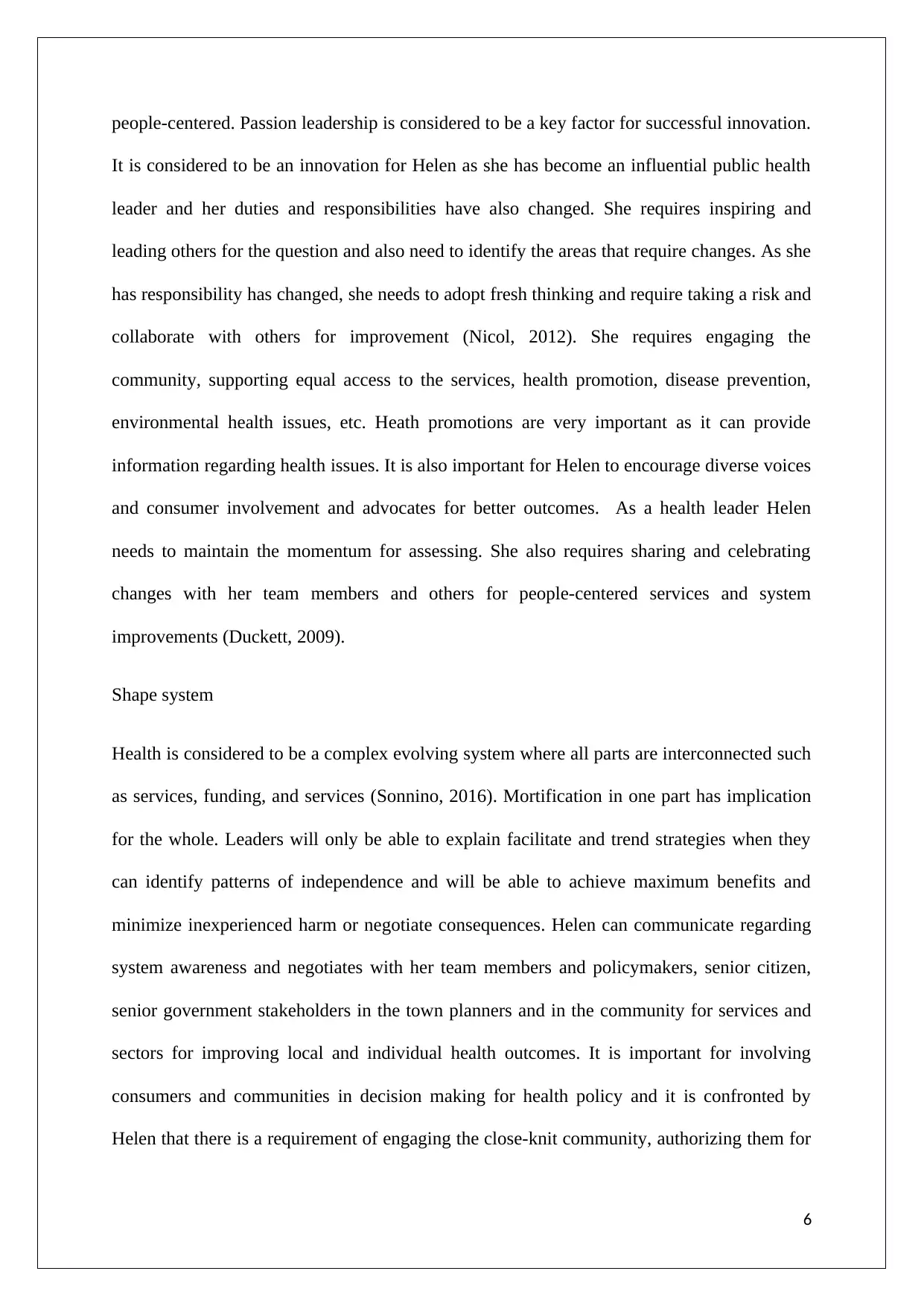
people-centered. Passion leadership is considered to be a key factor for successful innovation.
It is considered to be an innovation for Helen as she has become an influential public health
leader and her duties and responsibilities have also changed. She requires inspiring and
leading others for the question and also need to identify the areas that require changes. As she
has responsibility has changed, she needs to adopt fresh thinking and require taking a risk and
collaborate with others for improvement (Nicol, 2012). She requires engaging the
community, supporting equal access to the services, health promotion, disease prevention,
environmental health issues, etc. Heath promotions are very important as it can provide
information regarding health issues. It is also important for Helen to encourage diverse voices
and consumer involvement and advocates for better outcomes. As a health leader Helen
needs to maintain the momentum for assessing. She also requires sharing and celebrating
changes with her team members and others for people-centered services and system
improvements (Duckett, 2009).
Shape system
Health is considered to be a complex evolving system where all parts are interconnected such
as services, funding, and services (Sonnino, 2016). Mortification in one part has implication
for the whole. Leaders will only be able to explain facilitate and trend strategies when they
can identify patterns of independence and will be able to achieve maximum benefits and
minimize inexperienced harm or negotiate consequences. Helen can communicate regarding
system awareness and negotiates with her team members and policymakers, senior citizen,
senior government stakeholders in the town planners and in the community for services and
sectors for improving local and individual health outcomes. It is important for involving
consumers and communities in decision making for health policy and it is confronted by
Helen that there is a requirement of engaging the close-knit community, authorizing them for
6
It is considered to be an innovation for Helen as she has become an influential public health
leader and her duties and responsibilities have also changed. She requires inspiring and
leading others for the question and also need to identify the areas that require changes. As she
has responsibility has changed, she needs to adopt fresh thinking and require taking a risk and
collaborate with others for improvement (Nicol, 2012). She requires engaging the
community, supporting equal access to the services, health promotion, disease prevention,
environmental health issues, etc. Heath promotions are very important as it can provide
information regarding health issues. It is also important for Helen to encourage diverse voices
and consumer involvement and advocates for better outcomes. As a health leader Helen
needs to maintain the momentum for assessing. She also requires sharing and celebrating
changes with her team members and others for people-centered services and system
improvements (Duckett, 2009).
Shape system
Health is considered to be a complex evolving system where all parts are interconnected such
as services, funding, and services (Sonnino, 2016). Mortification in one part has implication
for the whole. Leaders will only be able to explain facilitate and trend strategies when they
can identify patterns of independence and will be able to achieve maximum benefits and
minimize inexperienced harm or negotiate consequences. Helen can communicate regarding
system awareness and negotiates with her team members and policymakers, senior citizen,
senior government stakeholders in the town planners and in the community for services and
sectors for improving local and individual health outcomes. It is important for involving
consumers and communities in decision making for health policy and it is confronted by
Helen that there is a requirement of engaging the close-knit community, authorizing them for
6
⊘ This is a preview!⊘
Do you want full access?
Subscribe today to unlock all pages.

Trusted by 1+ million students worldwide
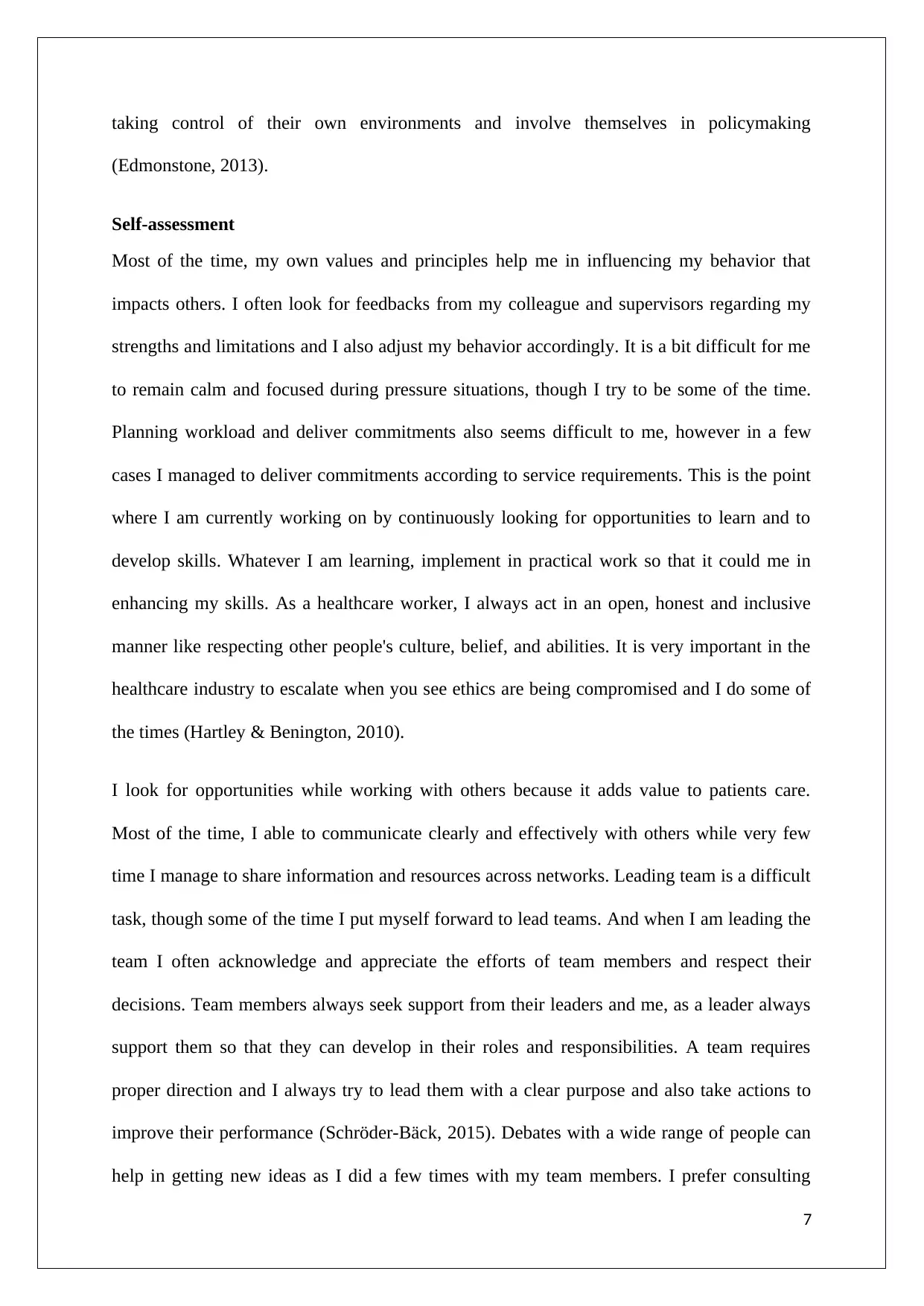
taking control of their own environments and involve themselves in policymaking
(Edmonstone, 2013).
Self-assessment
Most of the time, my own values and principles help me in influencing my behavior that
impacts others. I often look for feedbacks from my colleague and supervisors regarding my
strengths and limitations and I also adjust my behavior accordingly. It is a bit difficult for me
to remain calm and focused during pressure situations, though I try to be some of the time.
Planning workload and deliver commitments also seems difficult to me, however in a few
cases I managed to deliver commitments according to service requirements. This is the point
where I am currently working on by continuously looking for opportunities to learn and to
develop skills. Whatever I am learning, implement in practical work so that it could me in
enhancing my skills. As a healthcare worker, I always act in an open, honest and inclusive
manner like respecting other people's culture, belief, and abilities. It is very important in the
healthcare industry to escalate when you see ethics are being compromised and I do some of
the times (Hartley & Benington, 2010).
I look for opportunities while working with others because it adds value to patients care.
Most of the time, I able to communicate clearly and effectively with others while very few
time I manage to share information and resources across networks. Leading team is a difficult
task, though some of the time I put myself forward to lead teams. And when I am leading the
team I often acknowledge and appreciate the efforts of team members and respect their
decisions. Team members always seek support from their leaders and me, as a leader always
support them so that they can develop in their roles and responsibilities. A team requires
proper direction and I always try to lead them with a clear purpose and also take actions to
improve their performance (Schröder-Bäck, 2015). Debates with a wide range of people can
help in getting new ideas as I did a few times with my team members. I prefer consulting
7
(Edmonstone, 2013).
Self-assessment
Most of the time, my own values and principles help me in influencing my behavior that
impacts others. I often look for feedbacks from my colleague and supervisors regarding my
strengths and limitations and I also adjust my behavior accordingly. It is a bit difficult for me
to remain calm and focused during pressure situations, though I try to be some of the time.
Planning workload and deliver commitments also seems difficult to me, however in a few
cases I managed to deliver commitments according to service requirements. This is the point
where I am currently working on by continuously looking for opportunities to learn and to
develop skills. Whatever I am learning, implement in practical work so that it could me in
enhancing my skills. As a healthcare worker, I always act in an open, honest and inclusive
manner like respecting other people's culture, belief, and abilities. It is very important in the
healthcare industry to escalate when you see ethics are being compromised and I do some of
the times (Hartley & Benington, 2010).
I look for opportunities while working with others because it adds value to patients care.
Most of the time, I able to communicate clearly and effectively with others while very few
time I manage to share information and resources across networks. Leading team is a difficult
task, though some of the time I put myself forward to lead teams. And when I am leading the
team I often acknowledge and appreciate the efforts of team members and respect their
decisions. Team members always seek support from their leaders and me, as a leader always
support them so that they can develop in their roles and responsibilities. A team requires
proper direction and I always try to lead them with a clear purpose and also take actions to
improve their performance (Schröder-Bäck, 2015). Debates with a wide range of people can
help in getting new ideas as I did a few times with my team members. I prefer consulting
7
Paraphrase This Document
Need a fresh take? Get an instant paraphrase of this document with our AI Paraphraser
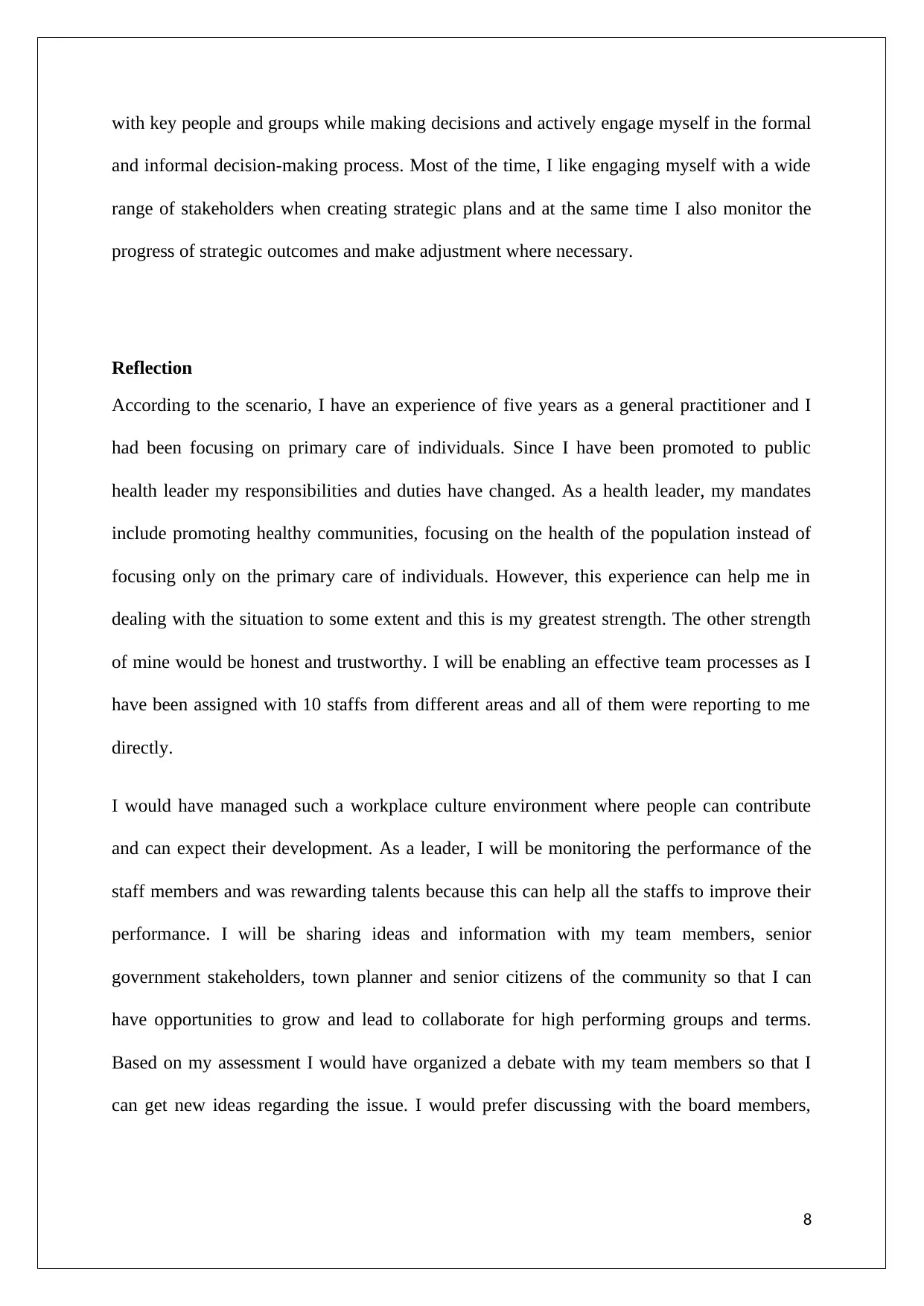
with key people and groups while making decisions and actively engage myself in the formal
and informal decision-making process. Most of the time, I like engaging myself with a wide
range of stakeholders when creating strategic plans and at the same time I also monitor the
progress of strategic outcomes and make adjustment where necessary.
Reflection
According to the scenario, I have an experience of five years as a general practitioner and I
had been focusing on primary care of individuals. Since I have been promoted to public
health leader my responsibilities and duties have changed. As a health leader, my mandates
include promoting healthy communities, focusing on the health of the population instead of
focusing only on the primary care of individuals. However, this experience can help me in
dealing with the situation to some extent and this is my greatest strength. The other strength
of mine would be honest and trustworthy. I will be enabling an effective team processes as I
have been assigned with 10 staffs from different areas and all of them were reporting to me
directly.
I would have managed such a workplace culture environment where people can contribute
and can expect their development. As a leader, I will be monitoring the performance of the
staff members and was rewarding talents because this can help all the staffs to improve their
performance. I will be sharing ideas and information with my team members, senior
government stakeholders, town planner and senior citizens of the community so that I can
have opportunities to grow and lead to collaborate for high performing groups and terms.
Based on my assessment I would have organized a debate with my team members so that I
can get new ideas regarding the issue. I would prefer discussing with the board members,
8
and informal decision-making process. Most of the time, I like engaging myself with a wide
range of stakeholders when creating strategic plans and at the same time I also monitor the
progress of strategic outcomes and make adjustment where necessary.
Reflection
According to the scenario, I have an experience of five years as a general practitioner and I
had been focusing on primary care of individuals. Since I have been promoted to public
health leader my responsibilities and duties have changed. As a health leader, my mandates
include promoting healthy communities, focusing on the health of the population instead of
focusing only on the primary care of individuals. However, this experience can help me in
dealing with the situation to some extent and this is my greatest strength. The other strength
of mine would be honest and trustworthy. I will be enabling an effective team processes as I
have been assigned with 10 staffs from different areas and all of them were reporting to me
directly.
I would have managed such a workplace culture environment where people can contribute
and can expect their development. As a leader, I will be monitoring the performance of the
staff members and was rewarding talents because this can help all the staffs to improve their
performance. I will be sharing ideas and information with my team members, senior
government stakeholders, town planner and senior citizens of the community so that I can
have opportunities to grow and lead to collaborate for high performing groups and terms.
Based on my assessment I would have organized a debate with my team members so that I
can get new ideas regarding the issue. I would prefer discussing with the board members,
8
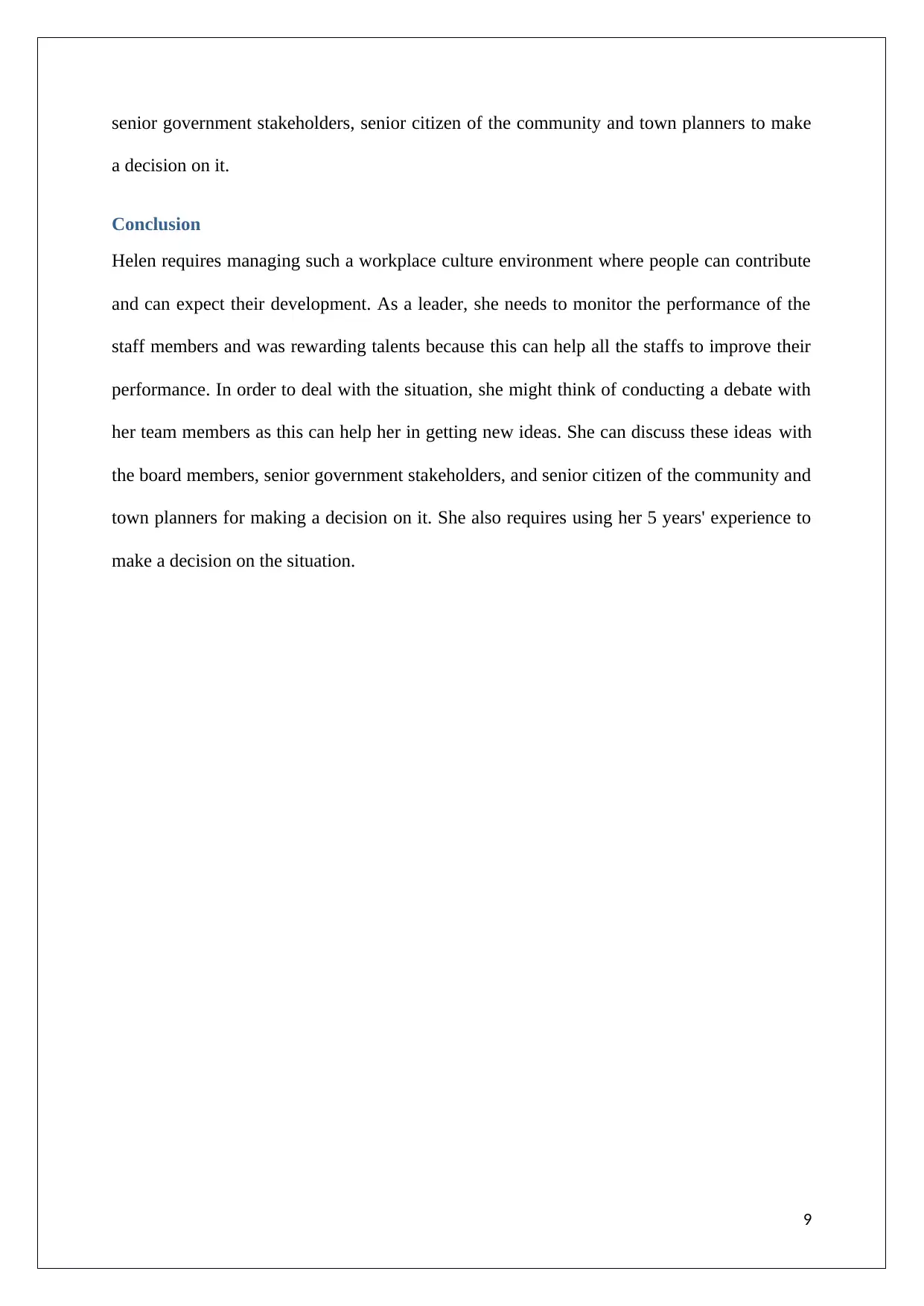
senior government stakeholders, senior citizen of the community and town planners to make
a decision on it.
Conclusion
Helen requires managing such a workplace culture environment where people can contribute
and can expect their development. As a leader, she needs to monitor the performance of the
staff members and was rewarding talents because this can help all the staffs to improve their
performance. In order to deal with the situation, she might think of conducting a debate with
her team members as this can help her in getting new ideas. She can discuss these ideas with
the board members, senior government stakeholders, and senior citizen of the community and
town planners for making a decision on it. She also requires using her 5 years' experience to
make a decision on the situation.
9
a decision on it.
Conclusion
Helen requires managing such a workplace culture environment where people can contribute
and can expect their development. As a leader, she needs to monitor the performance of the
staff members and was rewarding talents because this can help all the staffs to improve their
performance. In order to deal with the situation, she might think of conducting a debate with
her team members as this can help her in getting new ideas. She can discuss these ideas with
the board members, senior government stakeholders, and senior citizen of the community and
town planners for making a decision on it. She also requires using her 5 years' experience to
make a decision on the situation.
9
⊘ This is a preview!⊘
Do you want full access?
Subscribe today to unlock all pages.

Trusted by 1+ million students worldwide
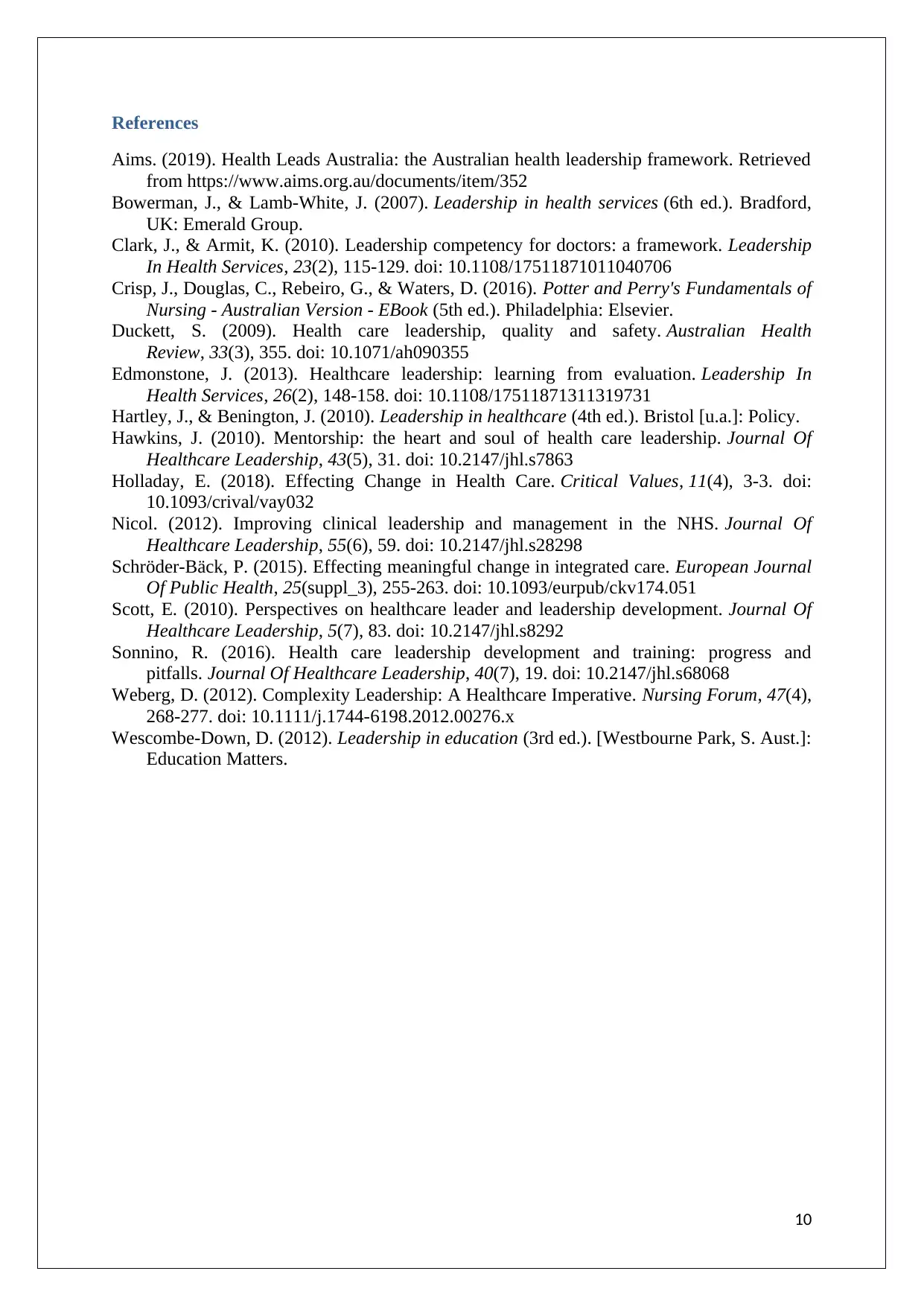
References
Aims. (2019). Health Leads Australia: the Australian health leadership framework. Retrieved
from https://www.aims.org.au/documents/item/352
Bowerman, J., & Lamb-White, J. (2007). Leadership in health services (6th ed.). Bradford,
UK: Emerald Group.
Clark, J., & Armit, K. (2010). Leadership competency for doctors: a framework. Leadership
In Health Services, 23(2), 115-129. doi: 10.1108/17511871011040706
Crisp, J., Douglas, C., Rebeiro, G., & Waters, D. (2016). Potter and Perry's Fundamentals of
Nursing - Australian Version - EBook (5th ed.). Philadelphia: Elsevier.
Duckett, S. (2009). Health care leadership, quality and safety. Australian Health
Review, 33(3), 355. doi: 10.1071/ah090355
Edmonstone, J. (2013). Healthcare leadership: learning from evaluation. Leadership In
Health Services, 26(2), 148-158. doi: 10.1108/17511871311319731
Hartley, J., & Benington, J. (2010). Leadership in healthcare (4th ed.). Bristol [u.a.]: Policy.
Hawkins, J. (2010). Mentorship: the heart and soul of health care leadership. Journal Of
Healthcare Leadership, 43(5), 31. doi: 10.2147/jhl.s7863
Holladay, E. (2018). Effecting Change in Health Care. Critical Values, 11(4), 3-3. doi:
10.1093/crival/vay032
Nicol. (2012). Improving clinical leadership and management in the NHS. Journal Of
Healthcare Leadership, 55(6), 59. doi: 10.2147/jhl.s28298
Schröder-Bäck, P. (2015). Effecting meaningful change in integrated care. European Journal
Of Public Health, 25(suppl_3), 255-263. doi: 10.1093/eurpub/ckv174.051
Scott, E. (2010). Perspectives on healthcare leader and leadership development. Journal Of
Healthcare Leadership, 5(7), 83. doi: 10.2147/jhl.s8292
Sonnino, R. (2016). Health care leadership development and training: progress and
pitfalls. Journal Of Healthcare Leadership, 40(7), 19. doi: 10.2147/jhl.s68068
Weberg, D. (2012). Complexity Leadership: A Healthcare Imperative. Nursing Forum, 47(4),
268-277. doi: 10.1111/j.1744-6198.2012.00276.x
Wescombe-Down, D. (2012). Leadership in education (3rd ed.). [Westbourne Park, S. Aust.]:
Education Matters.
10
Aims. (2019). Health Leads Australia: the Australian health leadership framework. Retrieved
from https://www.aims.org.au/documents/item/352
Bowerman, J., & Lamb-White, J. (2007). Leadership in health services (6th ed.). Bradford,
UK: Emerald Group.
Clark, J., & Armit, K. (2010). Leadership competency for doctors: a framework. Leadership
In Health Services, 23(2), 115-129. doi: 10.1108/17511871011040706
Crisp, J., Douglas, C., Rebeiro, G., & Waters, D. (2016). Potter and Perry's Fundamentals of
Nursing - Australian Version - EBook (5th ed.). Philadelphia: Elsevier.
Duckett, S. (2009). Health care leadership, quality and safety. Australian Health
Review, 33(3), 355. doi: 10.1071/ah090355
Edmonstone, J. (2013). Healthcare leadership: learning from evaluation. Leadership In
Health Services, 26(2), 148-158. doi: 10.1108/17511871311319731
Hartley, J., & Benington, J. (2010). Leadership in healthcare (4th ed.). Bristol [u.a.]: Policy.
Hawkins, J. (2010). Mentorship: the heart and soul of health care leadership. Journal Of
Healthcare Leadership, 43(5), 31. doi: 10.2147/jhl.s7863
Holladay, E. (2018). Effecting Change in Health Care. Critical Values, 11(4), 3-3. doi:
10.1093/crival/vay032
Nicol. (2012). Improving clinical leadership and management in the NHS. Journal Of
Healthcare Leadership, 55(6), 59. doi: 10.2147/jhl.s28298
Schröder-Bäck, P. (2015). Effecting meaningful change in integrated care. European Journal
Of Public Health, 25(suppl_3), 255-263. doi: 10.1093/eurpub/ckv174.051
Scott, E. (2010). Perspectives on healthcare leader and leadership development. Journal Of
Healthcare Leadership, 5(7), 83. doi: 10.2147/jhl.s8292
Sonnino, R. (2016). Health care leadership development and training: progress and
pitfalls. Journal Of Healthcare Leadership, 40(7), 19. doi: 10.2147/jhl.s68068
Weberg, D. (2012). Complexity Leadership: A Healthcare Imperative. Nursing Forum, 47(4),
268-277. doi: 10.1111/j.1744-6198.2012.00276.x
Wescombe-Down, D. (2012). Leadership in education (3rd ed.). [Westbourne Park, S. Aust.]:
Education Matters.
10
1 out of 10
Related Documents
Your All-in-One AI-Powered Toolkit for Academic Success.
+13062052269
info@desklib.com
Available 24*7 on WhatsApp / Email
![[object Object]](/_next/static/media/star-bottom.7253800d.svg)
Unlock your academic potential
Copyright © 2020–2025 A2Z Services. All Rights Reserved. Developed and managed by ZUCOL.





